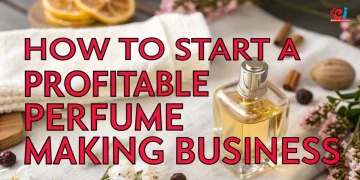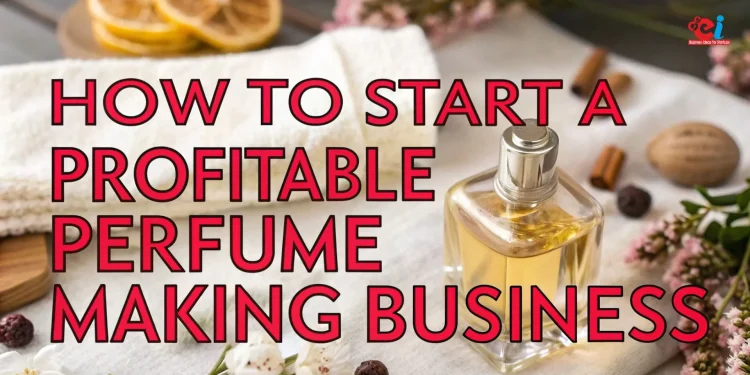Perfume Making Business has become more than a luxury product. It is a sensorial experience, a cultural icon, and an expression of individual identity. The fragrance industry in India and around the world has grown beyond the elite consumer to include middle-income consumers and mass-market segments. No longer are perfumes reserved only for special occasions or weddings. Today, perfumes are used by students, professionals, parents, and children every day in a variety of forms, from deodorants to body sprays, essential oils, and attars.
Perfume Making business is a lucrative and exciting business opportunity. This industry has high profit margins, a wide range of product lines and a strong brand potential. It is also suitable for both small-scale businesses and industrial setups that are export-driven, which allows growth on multiple levels. This guide is for those who are considering a new business venture. It will help you understand the potential of the Indian market, its product scope, its manufacturing process, its regulatory environment, and how to build a brand.
Understanding the Market Potential
India’s perfume market is set to grow exponentially, thanks to changing consumer tastes, rising disposable incomes and a growing interest in personal grooming. Indian consumers prefer homegrown brands, which offer high-quality products at low prices, over global powerhouses such as Dior, Chanel, and Gucci. This trend provides a fertile environment for entrepreneurs to launch niche products, such as ayurvedic or regionally inspired perfumes.
The global Perfume Making Business is estimated to be worth approximately USD 49.85 billion in 2020 and will reach USD 69.25billion by 2027. This growth will occur at a CAGR of about 6.4%. India is a market that has seen rapid growth. The Indian fragrance sector was estimated at approximately R11,000 crore in 2022. Projections indicate a rise to R17,000 crore by 2027, marking an increase of more than 9 percent.
It’s interesting to note that this growth is not only driven by the premium segment. The mid-tier and budget perfumes, especially those priced under Rs 500, are gaining traction on platforms such as Amazon, Flipkart, and Myntra. India is also seeing a rise in demand for traditional attars, essential oil-based and alcohol-free perfumes. These are popular in the Gulf, Southeast Asia, and Africa.
Perfumes You Can Make
It is important to know the types of perfumes on the market and who they are intended for. Eau de Parfums (EDP) with their higher concentrations of fragrance oils cater to customers who are looking for long-lasting scents. Eau de Toilette, which is lighter and aimed at the middle-range market, primarily professionals and young college students, is a popular choice. Deodorants and body mists are most popular among the Indian mass market.
traditional Attars, which are natural, distilled perfumes that do not contain alcohol and are popular with religious communities as well as being in high demand on export markets. They are typically extracted using ancient Indian techniques from sources such as roses, jasmine and sandalwood.
Entrepreneurs looking to innovate can diversify their product line by using room fresheners and car perfumes.
Related: Profit-Making Business for Startups
Step-by-Step Perfume Manufacturing Process
Perfume Making Business is both an art and a science. It involves mixing essential oils with solvents, aromachemicals and fixatives at precise ratios to produce a scent which is pleasant and lasts a long time. The basic formula is simple but achieving quality and consistency on a large scale requires careful control of raw materials, processing and aging conditions.
1. Formula Development and Scent Design
It all begins with the creation of a fragrance. It is necessary to experiment with the base notes, such as musk or sandalwood, middle notes like rose or jasmine and top notes like citrus or mint. The “nose” of the perfumer creates scent profiles by combining notes. A summer fragrance may be dominated by citrus and aquatic tones, whereas winter scents might favor spicy or wooden notes. The combinations are then tested in small batches repeatedly until the formula is stable.
2. Procurement and Quality Control of Raw Materials
Next, you need to source high-quality materials. This includes essential oils like lavender, lemongrass or ylang ylang, solvents such as water or ethanol (depending on formula) and fixatives that help preserve the scent. Aroma chemicals that mimic natural scents, or create new ones are also used widely in modern perfume manufacturing. It’s important to buy materials that are IFRA compliant, especially if your plan is to export or to work with retail chains.
All materials entering the production process should be checked for quality, including purity, allergen levels and contamination. This will ensure that the final product is safe for consumers and meets their standards.
3. Blending and Aging
Blending takes place once all ingredients have been approved in containers lined with stainless steel or tempered glass. In a controlled environment, the aromatic compounds are mixed with solvents. The ratios of the blend are crucial, since they determine the strength, durability, and projection.
The perfume must be macerated or aged after blending. This stage can last from a week to several months. It allows the fragrance components time to integrate and mature. The scent profile is enhanced by aging, which makes it more refined and smoother. To protect volatile compounds from heat and light degradation, it must be done in a cool, dark room.
4. Filtration and Clarification
After aging, the mixture will be filtered to remove impurities or sediments. Microfiltration is used to ensure clarity and avoid cloudiness in the finished product. Some manufacturers chill the blend at this stage to accelerate sedimentation and improve scent crispness.
5. Bottled and final packaging
After the perfume has been filtered, it can be packaged. This process is done on a sanitized semi-automatic, or automatic filling machine, depending on how large the operation is. The bottles must be leak-proof and airtight. EDPs and EDTs are usually stored in spray bottles, while attars can be found in dropper or glass roll-on bottles.
Labeling is important. Labels should clearly state your brand, product information, batch number, expiration dates, and ingredients. Multilingual barcoding and labeling may be required for export units.
Related: Turn Profitable Indian Perfumes Into a Global Export Business
Regulatory Landscape and Quality Standards
The Indian fragrance manufacturing industry is regulated by several regulatory agencies. The Drugs and Cosmetics Act of 1940 governs products classified as cosmetics. Alcohol-based fragrances may require licenses, depending on the content and application. The Bureau of Indian Standards sets standards for personal care products. Following these standards not only ensures compliance but also enhances the credibility of your product.
Before you can start full-scale production, you will need to comply with Guidelines for Legal Metrology, Pollution Control Norms, and Factory Licenses. Registration with the Directorate General of Foreign Trade is required if you are exporting. You will also need to obtain a Goods & Services Tax (GST), number.
For those who are targeting the overseas market, it is highly recommended that they comply with International Fragrance Association as this governs ingredients and concentrations.
Branding, Sales Strategy, and Marketing Strategy
Perception and emotion are the lifeblood of the perfume industry. The fragrance is rarely purchased based solely on the ingredients. Instead, consumers are more likely to buy it based on the storyline, the image and the experience. Branding plays a crucial role in this.
Your brand identity should be a reflection of the values that you want to convey, whether it’s luxury, tradition, innovation, or nature. A product that uses traditional Indian flowers and herbs can be positioned as an “Ayurvedic Fragrance” and appeal to both domestic and international wellness audiences. A minimalist, clean brand might appeal to urban professionals and millennials.
Your distribution strategy must be just as sharp. Multi-channel approaches, which combine e-commerce platforms, offline retail tie ups, and B2B partnership, are often the most effective. Subscription-based business models, custom perfumes or private label manufacturing of lifestyle brands can also be integrated into your model.
The Key Challenges of the Digital Age and How to Solve Them
The challenges of starting a fragrance business are also numerous. It is important to maintain consistency when creating fragrance batches. This is especially true when using essential oils that can change in properties from season to season. This problem can be mitigated by investing in quality control systems, and keeping track of batch records.
The shelf life and storage of essential oils are important. Aromatic oils and essential oils are affected by light, temperature and air exposure. The manufacturers must store their products in airtight, climate-controlled containers.
regulatory compliance is another key challenge. Fragrance ingredients undergo constant scrutiny to determine if they are allergens or pose health risks. To stay safe and competitive, it is important to keep up with the latest banned substances lists and make changes in formulations.
Last but not least, you will have to compete with global brands that are already established. Here, creating a unique identity through ayurvedic principles, sustainability or cultural positioning can be your best defense.
For more information check out this video
How the NPCS can help entrepreneurs in perfume manufacturing
Niir Project Consultancy Services is a trusted consulting firm with years of experience helping companies set up successful industrial ventures. NPCS provides Market Study cum Detailed Technoeconomic Feasibility Reports to guide entrepreneurs at every stage of their business journey. These reports contain information about manufacturing processes, raw materials, plant layouts and technical insights to help you avoid costly errors. NPCS helps entrepreneurs evaluate the feasibility of new industrial setups and their market potential , allowing them to enter the perfume industry with more knowledge and strategy.
Which business to start? How to choose a business idea?
Conclusion
In the perfume business, art, science and commerce are all combined in equal measures. There has never been a more exciting time to get into this industry. With the growing demand for local, high-quality scents and changing consumer habits, it is a great opportunity. Entrepreneurs can build a lasting legacy in the world scents by investing in quality and creating a brand with emotional resonance.
can help you transform your passion for aromatic oils into an industrial venture that is profitable.
You can consult to get a complete project report, including a feasibility assessment. Great businesses start with good planning.


















